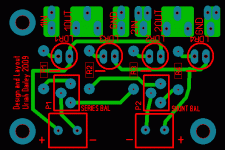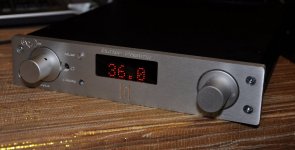Tripmaster, have you got an optivol too?
Hi Salas
I haven't built my DCB1 yet. I'm just using Uriah's LDR mount and balance board.
Hmm maybe a pattern is emerging here, showing that the guys with such style volume controls tend to get affected. If it is not a ground loop, pay attention in Tx magnetic field susceptibility. Change location and angle of enclosed transformers to know if its a factor. If your harmonic noise is altering its audibility or tone by doing that, then you are on to something to solve. When you need to widen the loop area of the signal routed around on specialized pcbs with additional in/out cabling also VS just a small pot, it can be more exposed, its natural.
Hmm maybe a pattern is emerging here.
Hi Salas
Are you trying to be funny?
I repositioned the L/S transformer and bridge this morning and it didn't appear to make a difference. It certainly sounds like we have a very similar hum. My hum sounds exactly like the hum coming from my F5 transformer. I've also altered the position of the amp transformer to no avail. I'm sure its something very simple.
I know you guys have seen this but for anyone wondering if there could be a ground loop they can view the last page on this pdf for a schematic.
https://docs.google.com/fileview?id...DUtZTkyOS00YjU2LTk1ZDEtZjZiYjg1OTNjMzdm&hl=en
The second to last page has a pic of the board. You can see the signal comes in, goes through first resistor side of LDR then out to amp. Where it comes out to amp there is a second LDR and the resistor side of it connects to output and the other side goes to signal GND. Its the same for both channels and Signal GND is not connected to each other on the board but there is an extra through hole so that you can connect them if you choose. I do not connect signal ground to any other ground in my builds and I do not have hum. On my second to last build I DID have hum and it was in the preamp. I did two things which eliminated the hum. More of a buzz actually. I took the 0V from the LDR attenuator power supply and tied it to earth ground. More than half of hum was gone at that point. Then I was just messing around with the signal wires and moving them while listening and found that two of them were to close together and that when separated from each other the hum disappeared. When I put my head right on the 96db driver, seriously only on inch, I could only hear it directly in front of the center of the cone. One inch left or right and it was gone. Battery power cured that but I still run without battery as I dont like changing them out. I suspect its the power supply if its a problem with the LDR attenuator. But other than that I dont know what it is. The signal passes only through the LDRs and they are in a potentiometer configuration. Unless the power supply you use is creating noise its got to be somewhere else. I know you have to take what I say with a grain of salt because I do sell these, but thats my honest opinion. I hope you guys get it sorted and I watch this thread plus F5. I have had nothing I could contribute that others have not said. If I find anything or notice a fix by reading your evaluations of your problem I will definitely jump in.
Uriah
https://docs.google.com/fileview?id...DUtZTkyOS00YjU2LTk1ZDEtZjZiYjg1OTNjMzdm&hl=en
The second to last page has a pic of the board. You can see the signal comes in, goes through first resistor side of LDR then out to amp. Where it comes out to amp there is a second LDR and the resistor side of it connects to output and the other side goes to signal GND. Its the same for both channels and Signal GND is not connected to each other on the board but there is an extra through hole so that you can connect them if you choose. I do not connect signal ground to any other ground in my builds and I do not have hum. On my second to last build I DID have hum and it was in the preamp. I did two things which eliminated the hum. More of a buzz actually. I took the 0V from the LDR attenuator power supply and tied it to earth ground. More than half of hum was gone at that point. Then I was just messing around with the signal wires and moving them while listening and found that two of them were to close together and that when separated from each other the hum disappeared. When I put my head right on the 96db driver, seriously only on inch, I could only hear it directly in front of the center of the cone. One inch left or right and it was gone. Battery power cured that but I still run without battery as I dont like changing them out. I suspect its the power supply if its a problem with the LDR attenuator. But other than that I dont know what it is. The signal passes only through the LDRs and they are in a potentiometer configuration. Unless the power supply you use is creating noise its got to be somewhere else. I know you have to take what I say with a grain of salt because I do sell these, but thats my honest opinion. I hope you guys get it sorted and I watch this thread plus F5. I have had nothing I could contribute that others have not said. If I find anything or notice a fix by reading your evaluations of your problem I will definitely jump in.
Uriah
Here is a pic of the copper so you can see signal. The only thing I can think, if there is an issue on this board, is that the positive trace for power to the LDR 1 and 2 is near the signal inputs/outputs. I wonder if you cut that trace on both ends near where it meets the LDRs and replace it with a wire?? I cant see any other way for noise to get in except for something external to the board.
Uriah
Uriah
Attachments
Richard, noisy supplies make noisy LDRs. Try sticking 10-100uf on the LDR LED leads. If you dont want to solder directly to the LDRs, which I would completely understand, then you could solder from positive power input to each of the pot's pins minus the wipers. So a small electrolytic from positive input to A and B but not W of each pot. 4 caps. You could put a small .1uf to .47uf film cap parallel with each electro before you solder it on. This will help quiet power supply noise. Shooting in the dark here but its worth a try and it will improve the sound anyway, thats a guarantee.
hum symmetric supply DCB1 + LDR pot configs
i suspect that the hum problem will be helped with udailey's cap fix. as the DCB1 is DC coupled and single-ended, a change in source impedance (e.g. the shunt half of the LDR changes impedance in sync with psu ripple) multiplied by the DCB1's input bias (gate leakage) current (V = I* R) will cause the hum to appear at the DCB1's output.
i suspect that the hum problem will be helped with udailey's cap fix. as the DCB1 is DC coupled and single-ended, a change in source impedance (e.g. the shunt half of the LDR changes impedance in sync with psu ripple) multiplied by the DCB1's input bias (gate leakage) current (V = I* R) will cause the hum to appear at the DCB1's output.
i suspect that the hum problem will be helped with udailey's cap fix. as the DCB1 is DC coupled and single-ended, a change in source impedance (e.g. the shunt half of the LDR changes impedance in sync with psu ripple) multiplied by the DCB1's input bias (gate leakage) current (V = I* R) will cause the hum to appear at the DCB1's output.
Tripmaster does not have it with a DCB1 yet. Malka has an extra dedicated reg for his optivol.
Perhaps some elimination is needed here. If someone with a LDR could quickly substitute in a regular pot and see if the hums goes, and likewise, use the LDR but not the B1 and see does the hum go. At least that would rule out the LDRs.
I did try the DCB1 with a home built LDR (that wasn't very well matched). There was no hum at all - but that was just P2P wired.
Fran
I did try the DCB1 with a home built LDR (that wasn't very well matched). There was no hum at all - but that was just P2P wired.
Fran
hummmm
Hi Tincan
I removed the LDR board last night to make it easier to solder the copper bar to the RCA ground terminals. Whilst detached I decided to solder a 10uf cap to each of the LDRs. The sound changed for sure, but the hum remained. I have a spare MUR860 bridge so I'll swap the current one for this and I'll report back
maybe the hum is related to noise generated not from the xfmr itself but the diode bridge, series R, main caps, and their wiring.
Hi Tincan
I removed the LDR board last night to make it easier to solder the copper bar to the RCA ground terminals. Whilst detached I decided to solder a 10uf cap to each of the LDRs. The sound changed for sure, but the hum remained. I have a spare MUR860 bridge so I'll swap the current one for this and I'll report back
Ok here is my real box for my DCB1,
not a drawing anymore....
still missing a couple of pushbuttons and centering of display...but i like it's looks.
Now for the interior !
Nice. It misses the DC on the legend. Was it machined for the original B1 and plans changed?
no...it's you, your too quick, i was uploading pic....
It looks excellent
Yes Salas,
i still have to figure out how to put the "DC" in without spoiling the layout....your Blue Edition board is going to be great in it
I'm populating it now and testing the relay boards.
Since the legend it centred already, it could only be added as a small typeface to its left. Like dcB1, but the dc at 1/3 scale?
- Home
- Amplifiers
- Pass Labs
- Building a symmetrical PSU B1 buffer

